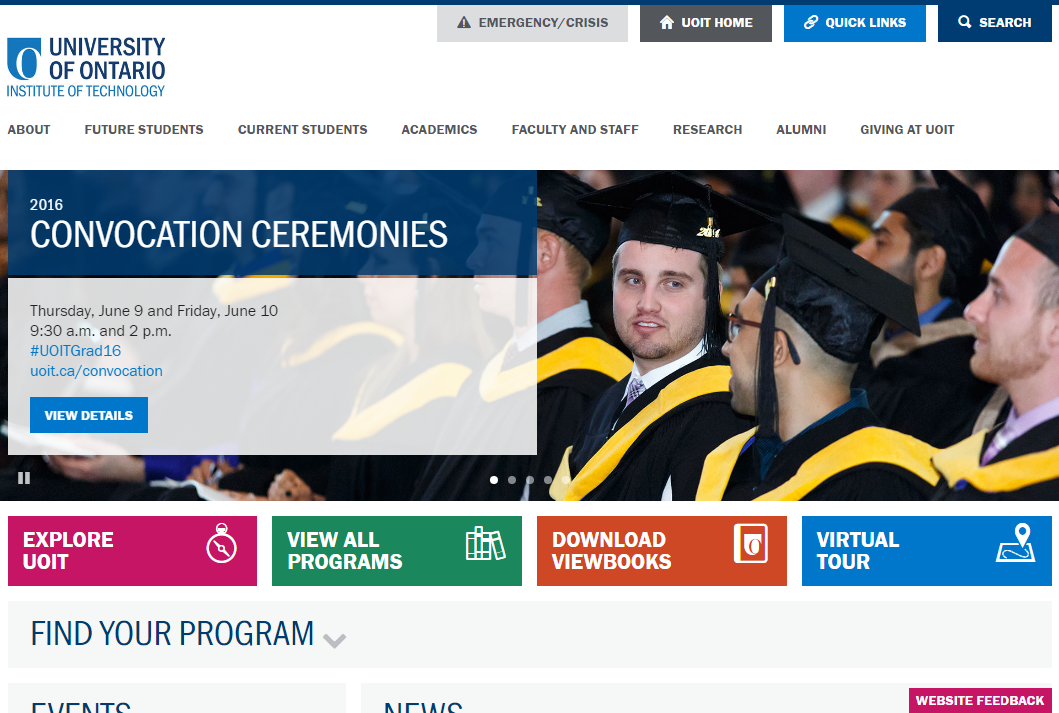
Region : Ontario
City : Oshawa
Web site : www.uoit.ca
The University of Ontario Institute of Technology (UOIT) is a public research university located in Oshawa, Ontario, Canada. The university shares its campus with Durham College. The university was founded in 2002 and accepted its first students in 2003, making it one of Canada's newest universities. The enabling legislation is the University of Ontario Institute of Technology Act, 2002. All undergraduate programs require students to lease a laptop PC from the university as a condition of enrollment, making it Ontario's only laptop-based university. Faculty members also encourage students to use their laptops to complete assignments, perform laboratory research and interact with faculty during lectures. UOIT offers a range of undergraduate programs, and graduate programs in Science, Engineering, Health and Information Technology. The UOIT campus is approximately 400 acres (160 ha) in the northern part of Oshawa.
UOIT has seven faculties, each offering several programs:
Faculty members are involved in research in a variety of areas. These include:
The Automotive Centre of Excellence (ACE) is the first testing and research centre of its kind in Canada, and in many respects the world. It is owned by UOIT and is located on the university’s north campus location.
ACE is a multi-purpose centre with an area of approximately 16,300 square metres. It is divided into two distinct sections: a core research facility (CRF) and an integrated research and training facility (IRTF).
The CRF offers full-size chambers that allow for full climatic, structural durability and life cycle testing including one of the largest and most sophisticated climatic wind tunnels on the planet. In this test chamber, wind speeds can exceed 240 kilometres per hour, temperatures range from -40 to +60 °C and relative humidity ranges from 5 to 95 per cent. The climatic wind tunnel has a unique variable nozzle that can optimize the airflow from 7 to 13 square metres (and larger) allowing for an unprecedented range of vehicle and test property sizes. Coupled with this feature is a large flexible chassis dynamometer that is integrated into an 11.5-metre turntable. Now, for the first time anywhere, vehicles and test properties can be turned into the airstream under full operating conditions to facilitate crosswind development. The large open chamber has a readily reconfigurable solar array that will replicate the effects of the sun and is hydrogen-capable, allowing for alternative fuels and fuel cell development.
The IRTF spans five floors with space dedicated for research, education and training. It has offices, laboratories, conference rooms and common work areas that are available to rent. This facility will foster an environment for collaboration and interaction between industry, researchers and students.
ACE is an independent test facility that is commercially available to customers who are seeking to bring their ideas into a proof of concept and ready for market. In addition to conventional automotive applications, ACE is suitable for testing alternative fuel, hybrid and electric vehicles. It is large enough to accommodate trucks, tandem drive systems, full coach buses, light rail transit, aerospace, military and agricultural applications, wind turbines and solar panels. ACE could be used to train military personnel, rescue crews or competitive athletes, to carry out performance testing of outdoor survival gear. ACE can assist the movie industry or test products that are subject to severe wind, humidity, snow, icing or desert heat.
ACE is available to rent by manufacturers, start-up companies and researchers. Clients can rent the entire facility or specific chambers at an hourly rate.
ACE was developed in partnership with UOIT, General Motors of Canada, the Government of Ontario, the Government of Canada and the Partners for the Advancement of Collaborative Engineering Education (PACE). The total cost of the facility is approximately $100 million.
The Energy Systems and Nuclear Science Research Centre (ERC) is a 9,290-square-metre facility that houses UOIT's unique-in-Canada education programs and research in geothermal, hydraulic, hydrogen, natural gas, nuclear solar and wind energy technologies. The ERC enables research in clean and green energies and technologies, and promotes Canada's entrepreneurial advantage through public-private research and commercialization partnerships.
Undergraduate, graduate and second-career training enrolment of energy scientists and nuclear engineers is projected to climb from 364 students in 2009-2010 to approximately 650 in 2012. These programs are complemented by Energy and Environmental options in UOIT’s Mechanical Engineering, Electrical Engineering and Science programs.
The tables on this website are converted with Div Table online tool. Please subscribe for an online HTML editor membership to stop adding promotional messages to your documents.
Sources : Wikipedia, www.uoit.ca